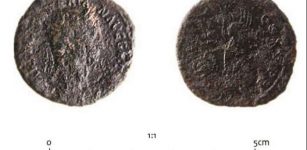Louhi – Witch Goddess Of The North And The Magical Artifact Sampo In Finnish Mythology
Ellen Lloyd - AncientPages.com - The Kalevala is one of the most significant works of Finnish literature. It's a book full of beautiful stories about heroes, villains, remarkable creatures, and wonderful adventures.
Compiled from Finnish and Karelian folklore in the 19th century, the book deeply impacted the young J.R.R. Tolkien and inspired his future books.
In the Kalevala, we encounter many complex and intriguing personalities, such as Lemminkainen, a war hero who is a prominent figure in Finnish mythology. There are many versions of the original Lemminkainen story because his complex character is a mix of traits originating from several other personalities of Finnish oral poetry.
The original Lemminkäinen in mythology is a shamanistic figure, but his roles and experiences frequently change in many different stories.
Another interesting figure mentioned in the Kalevala is Louhi, who is considered to be a witch and goddess of the North.
As a leader of Pohjola, the people of the North, her powers are great, and her daughters avidly sought after. Louhi possesses the power of magic, and at one point, she steals the Sun and Moon and locks them away.
Louhi is described as an evil witch and it's very likely she an alter-ego of the goddess Loviatar, a blind daughter of Tuoni, the god of death in Finnish mythology, and Tuonetar, the god of death in Finnish mythology underworld queen.
The Sampo – A Magical Artifact Which Louhi Tried To Steal
In Finnish mythology, the Sampo (or Sammas) was a magical artifact that many tried to steal, and one of them was Louhi.
The nature of the Sampo still remains shrouded in mystery, and scholars have attempted to explain the origin and purpose of the artifact.
The Sampo has been interpreted in many ways. It could have been a world pillar or world tree, a compass or astrolabe, a chest containing a treasure, a Byzantine coin die, a decorated Vendel period shield, a Christian relic, or something entirely different.
The Defense of the Sampo, shows Väinämöinen as he fights Louhi in the form of a winged monster carrying deformed Pohjola warriors on her back. Image credit: Akseli Gallen-Kallela
Some theories proposed that the Sampo was a world pillar, and it as such, it referred to the precession of the equinox. Though we do not know exactly what the Sampo was, it's clear from the stories in the Kalevala that it was a precious and "magical" object made of several magical ingredients, including a barley grain, a swan's quill tip, a barren cow's milk, and the wool of one ewe.
The Forging of the Sampo - Credit: Akseli Gallen-Kallela (1893) - Public Domain
The witch Louhi was the main opponent of Väinämöinen, an old hero with a magical voice and his group in the battle for the magical artifact Sampo in the Kalevala.
Louhi, who has many beautiful daughters, comes up with a cunning idea.
From one story, we learn that Louhi suggests that she will give her daughter's hand in marriage if the sage accomplishes the task of securing the Sampo.
When the smith Ilmarinen refuses to go to Pohjola, the heedless Väinämöinen forces him to comply —he too is eager to see the dream made real.
In the North, the reluctant Ilmarinen builds the Sampo, creating endless wealth for the northern people. Everything goes wrong, and soon the people of Kaleva and those of Pohjola are fighting over the Sampo. Eventually, the magic mill is destroyed in the battle, and the pieces sink to the bottom of the sea.
Updated on March 11, 2022
Written by - Ellen Lloyd – AncientPages.com
Copyright © AncientPages.com All rights reserved. This material may not be published, broadcast, rewritten or redistributed in whole or part without the express written permission of AncientPages.com
Expand for referencesMore From Ancient Pages
-
 Ancient Urartu Settlement, Water Tunnel And Rock Tombs Found In Erzurum, Eastern Turkey
Archaeology | Dec 19, 2017
Ancient Urartu Settlement, Water Tunnel And Rock Tombs Found In Erzurum, Eastern Turkey
Archaeology | Dec 19, 2017 -
 Researchers Find An Elusive European Ancestor Of Lager Yeast In Ireland
Archaeology | Dec 14, 2022
Researchers Find An Elusive European Ancestor Of Lager Yeast In Ireland
Archaeology | Dec 14, 2022 -
 Amazing Discovery: Great Pyramid Of Giza And Its Chambers Concentrate Electromagnetic Energy
Archaeology | Jul 31, 2018
Amazing Discovery: Great Pyramid Of Giza And Its Chambers Concentrate Electromagnetic Energy
Archaeology | Jul 31, 2018 -
 Amazing World’s Largest Mosaic Piece Made By 13 Different Ancient Civilizations At Museum Hotel Antakya
Featured Stories | May 9, 2019
Amazing World’s Largest Mosaic Piece Made By 13 Different Ancient Civilizations At Museum Hotel Antakya
Featured Stories | May 9, 2019 -
 Large Roman Public Latrine With 60 Wooden Seats Discovered In Bet Shean, Israel
Archaeology | Sep 25, 2023
Large Roman Public Latrine With 60 Wooden Seats Discovered In Bet Shean, Israel
Archaeology | Sep 25, 2023 -
 On This Day In History: King Tut’s Tomb Is Unsealed And Opened – On Feb 16,1923
News | Feb 16, 2017
On This Day In History: King Tut’s Tomb Is Unsealed And Opened – On Feb 16,1923
News | Feb 16, 2017 -
 Saqqara New Discoveries: Fifth Dynasty’s Pyramid Complex That Belonged To Queen Setibhor
Archaeology | Apr 15, 2019
Saqqara New Discoveries: Fifth Dynasty’s Pyramid Complex That Belonged To Queen Setibhor
Archaeology | Apr 15, 2019 -
 Homo Sapiens Survived In The Kalahari Desert More Than 20,000 Years Ago – Stone Age Discovery Shows
Archaeology | Aug 17, 2022
Homo Sapiens Survived In The Kalahari Desert More Than 20,000 Years Ago – Stone Age Discovery Shows
Archaeology | Aug 17, 2022 -
 Stunning Reconstruction Of Caterthun Iron Age Forts In The Grampian Mountains, Scotland
Civilizations | Nov 17, 2016
Stunning Reconstruction Of Caterthun Iron Age Forts In The Grampian Mountains, Scotland
Civilizations | Nov 17, 2016 -
 Unknown Sketch Of Jesus Christ By Leonardo Da Vinci Could Be The Holy Grail Of Art
News | Nov 24, 2020
Unknown Sketch Of Jesus Christ By Leonardo Da Vinci Could Be The Holy Grail Of Art
News | Nov 24, 2020 -
 Extremely Rare Jurassic Fossils Discovered Near Lake Powell, Utah
Fossils | Oct 16, 2023
Extremely Rare Jurassic Fossils Discovered Near Lake Powell, Utah
Fossils | Oct 16, 2023 -
 Mysterious Object In Asuka – The Place Of ‘Flying Birds’
Civilizations | Aug 11, 2018
Mysterious Object In Asuka – The Place Of ‘Flying Birds’
Civilizations | Aug 11, 2018 -
 Deciphered Ancient Stone Tablets Contain Sacred Knowledge That Could Re-Write History
Civilizations | Aug 28, 2018
Deciphered Ancient Stone Tablets Contain Sacred Knowledge That Could Re-Write History
Civilizations | Aug 28, 2018 -
 Shaka Zulu: African Hero And One Of Greatest Military Leaders Of All Time
Featured Stories | Nov 5, 2016
Shaka Zulu: African Hero And One Of Greatest Military Leaders Of All Time
Featured Stories | Nov 5, 2016 -
 Tabula Peutingeriana: Huge Ancient Roman Map Created By Unknown Cartographer
Artifacts | Dec 14, 2018
Tabula Peutingeriana: Huge Ancient Roman Map Created By Unknown Cartographer
Artifacts | Dec 14, 2018 -
 Magnificent Skellig Michael And A 1,400-Year Old Christian Monastery
Featured Stories | Feb 8, 2016
Magnificent Skellig Michael And A 1,400-Year Old Christian Monastery
Featured Stories | Feb 8, 2016 -
 Ptolemaic Workshop For Repairing And Construction Of Boats Unearthed In Sinai
Archaeology | Feb 21, 2019
Ptolemaic Workshop For Repairing And Construction Of Boats Unearthed In Sinai
Archaeology | Feb 21, 2019 -
 2nd Century Inscription Unearthed At Forum Of Ancient City Of Philippopolis, Bulgaria
Archaeology | Oct 21, 2019
2nd Century Inscription Unearthed At Forum Of Ancient City Of Philippopolis, Bulgaria
Archaeology | Oct 21, 2019 -
 Hoard Of Roman Bronze Coins Turns Out To Be Offering For Safe Crossing
Archaeology | Jul 2, 2021
Hoard Of Roman Bronze Coins Turns Out To Be Offering For Safe Crossing
Archaeology | Jul 2, 2021 -
 Unexplained Mysteries Of The Superstition Mountains – A Gateway To Other Worlds?
Featured Stories | Dec 15, 2020
Unexplained Mysteries Of The Superstition Mountains – A Gateway To Other Worlds?
Featured Stories | Dec 15, 2020



